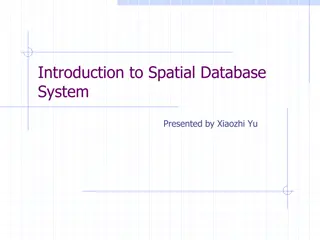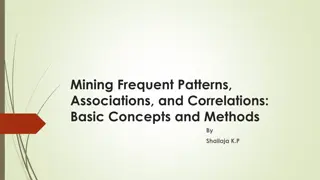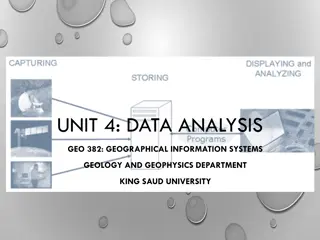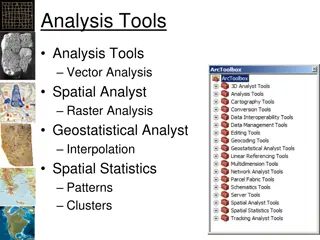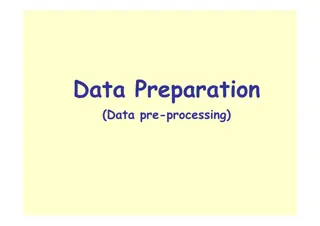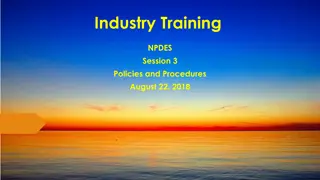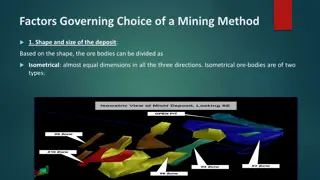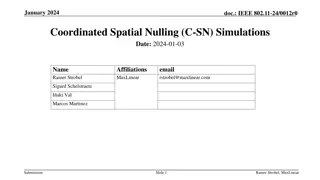Understanding Data Lifecycle and Mining for Business Intelligence
Explore the data life cycle, data mining, and knowledge discovery in business intelligence to transform data into valuable information for profitable business actions. Learn about data life cycle stages, data mining process, and data lifecycle management framework. Discover how data mining allows bu
2 views • 20 slides
Localised Adaptive Spatial-Temporal Graph Neural Network
This paper introduces the Localised Adaptive Spatial-Temporal Graph Neural Network model, focusing on the importance of spatial-temporal data modeling in graph structures. The challenges of balancing spatial and temporal dependencies for accurate inference are addressed, along with the use of distri
3 views • 19 slides
Introduction to Spatial Data Mining: Discovering Patterns in Large Datasets
Spatial data mining involves uncovering valuable patterns from extensive spatial datasets, offering insights into historical events, environmental phenomena, and predictive analytics. Examples range from analyzing disease outbreaks to predicting habitat suitability for endangered species. The applic
1 views • 20 slides
MINING CABLE: TYPE 440, 441, 450, 409, 406, 245, 275 & TYPE 2S AUSTRALIAN MINING
Znergy Cable TRAILING MINING Cable, Australian Cable has significant experience in a variety of mining cables that meet both the unique requirements of the Australian mining sector as well as those of the worldwide mining industry.
0 views • 5 slides
Understanding Spatial Database Systems: An Overview
This presentation by Xiaozhi Yu introduces the fundamentals of spatial database systems, covering topics such as spatial data types, relationships, system architecture, modeling, and organizing underlying spaces. It delves into the importance of integrating geometry into DBMS data models, spatial in
1 views • 30 slides
Perspectives on Mining Sector Management and Policy in Africa
The presentation by Prof. Plo Lumumba at the 2021 Mining Forum in Tanzania highlighted the potential of the mining sector to drive economic transformation in Africa. The continent, rich in mineral deposits, has the opportunity to shift towards a competitive upper-middle-income status by 2040. Howeve
1 views • 20 slides
Understanding Frequent Patterns and Association Rules in Data Mining
Frequent pattern mining involves identifying patterns that occur frequently in a dataset, such as itemsets and sequential patterns. These patterns play a crucial role in extracting associations, correlations, and insights from data, aiding decision-making processes like market basket analysis. Minin
1 views • 95 slides
Understanding Spatial Analysis in GIS for Effective Decision-Making
Spatial analysis in GIS involves modeling geographic problems, processing data, and exploring results to understand spatial relationships, patterns, and suitability for various purposes. GIS tools offer unique capabilities for handling geographically referenced data, data entry, storage, manipulatio
2 views • 21 slides
Understanding Spatial Referencing Systems for Mapping
Spatial reference systems play a crucial role in defining geographic parameters and coordinate systems for mapping. They consist of components like orientation, latitude, longitude, and elevation, which help in representing spatial properties on maps. Reference surfaces such as the Geoid and ellipso
3 views • 13 slides
Exploring Data Warehousing and Data Mining Concepts
This presentation delves into the realms of data warehousing and data mining, discussing concepts, techniques, and the importance of mining data for valuable insights. It covers topics such as the evolution of database technology, the significance of data mining, and the necessity for extracting kno
0 views • 32 slides
Spatial Analysis & Modeling for Spatial Planning Training in Maputo, Mozambique
Explore spatial analysis techniques for efficient route planning, site selection, pattern identification, and value prediction in the context of spatial planning. Learn about surface modeling, relationships among features, and the importance of spatial modeling in addressing geographical problems.
0 views • 27 slides
GIS Data Models for Spatial Planning Training in Maputo, Mozambique
Explore the concepts of GIS data models including vector vs. raster, spatial relationships, spatial operations, and representation of real-world entities in a spatial database. Understand how spatial data models are used to manipulate spatially-referenced information and define the spatial location
1 views • 32 slides
Legal Framework for the Mining Sector in Tanzania
The legal framework governing the mining sector in Tanzania is based on the Mining Act, Cap. 123, which regulates various aspects such as prospecting, mining, mineral processing, environmental compliance, and more. It outlines key issues including state control over mineral rights, acquisition of mi
0 views • 19 slides
Is Bitcoin Mining Profitable in 2024? Key Insights and Trends
Is Bitcoin Mining Profitable in 2024? provides an insightful exploration into the current state of Bitcoin mining, examining various factors that influence its profitability.\n\nIntroduction to Bitcoin Mining\n\nBitcoin mining involves verifying tran
0 views • 3 slides
Understanding Spatial Autocorrelation in Geostatistical Analysis
Explore the concept of spatial autocorrelation, its implications in geostatistical analysis, and the importance of detecting and interpreting it correctly. Learn about auto-correlation, signal components, correlation significance, and measuring autocorrelation using tools like Moran's I. Gain insigh
0 views • 12 slides
Women in Mining Sector: Challenges and Opportunities for Female Representation
Women in the mining sector play diverse roles but face challenges in representation and advancement. Globally, women make up only 8-12% of the mining workforce, with limitations in accessing managerial positions. Despite barriers, there are inspiring stories of women like Wilhmina Manaso breaking st
5 views • 12 slides
Spatial Relation Switching Requirements in 3GPP NR RAN Plenary Meeting
The document discusses various spatial relation switching requirements for uplink scenarios in the 3GPP NR RAN Plenary Meeting. It covers agreement points related to UL SRS, PUCCH, P-SRS, and DL-RS, defining delay requirements and known conditions for spatial relation switching. The agreements provi
0 views • 11 slides
Understanding Data Mining: Key Concepts and Applications
Data mining involves extracting valuable insights and patterns from vast amounts of data. This process includes data cleaning, integration, selection, transformation, mining, pattern evaluation, and knowledge presentation. The applications of data mining are diverse, ranging from market analysis and
0 views • 31 slides
Importance of Data Preparation in Data Mining
Data preparation, also known as data pre-processing, is a crucial step in the data mining process. It involves transforming raw data into a clean, structured format that is optimal for analysis. Proper data preparation ensures that the data is accurate, complete, and free of errors, allowing mining
1 views • 37 slides
Understanding Temporal and Spatial Information Models
This content delves into the intricacies of temporal and spatial information models, covering concepts such as existence, presence, and spatiotemporal relationships. It explores how entities are identified, events are witnessed, and durations are defined within these models. The interplay between ti
3 views • 9 slides
Exploring Crowd Mining: Humanity's Collective Mind Expansion
The concept of Crowd Mining involves searching for patterns in an open world with imprecise questions, requiring a new type of crowd-assisted mining process. It involves querying understanding, identifying relevant information sources, and interactive mining of human and computerized knowledge. Crow
0 views • 5 slides
Understanding Post-Mining Limits Under 47 CSR 30
Post-mining areas are classified based on completion of mining activities, contour restoration, and revegetation work. Classification is done outlet-by-outlet, with specific data requirements for precipitation-induced outlets before applying for post-mining limits. The determination for classificati
1 views • 40 slides
Factors Influencing Mining Method Selection
Factors affecting the selection of a mining method include the shape and size of the deposit, the deposit's contact with country rock, thickness of the ore body, and the dip of the deposit. The shape of the deposit, contact with country rock, and thickness of the ore body impact the feasibility and
0 views • 14 slides
Coordinated Spatial Nulling (C-SN) Simulations in IEEE 802.11-24/0012r0
The document discusses the concept of Coordinated Spatial Nulling (C-SN) in IEEE 802.11-24/0012r0, focusing on spatial nulling feedback, synchronization needs, advantages of partial nulling, and comparison of half-coordinated versus fully coordinated scenarios. Simulation results are presented, anal
0 views • 19 slides
Overview of Unit Operations in Mining
Unit operations in mining involve essential steps to extract minerals from deposits through processes like drilling, blasting, loading, and hauling. These operations are crucial for the successful extraction of minerals in both surface and underground mining. Efforts are being made to increase the c
0 views • 24 slides
Enhancing Spatial Data Analysis in QGIS
Explore the integration of relational databases with QGIS to facilitate efficient spatial data analysis. Discover the importance of recognizing spatial relationships within data sets and the solutions to enhance QGIS for relational datasets. Overcome challenges and delve into the intersection and su
0 views • 25 slides
International Conference on Fuzzy Systems and Data Mining 2024
The 10th International Conference on Fuzzy Systems and Data Mining (FSDM 2024) will be held in Matsue, Japan from Nov 5-8, 2024. The conference will feature presentations on various topics related to fuzzy systems, data mining, methodologies, results, and discussions. Participants will have the oppo
0 views • 8 slides
Trajectory Data Mining: Overview and Applications
Spatial trajectories represent moving objects in geographical spaces with examples from human mobility, transportation vehicles, animals, and natural phenomena. Sources of trajectory data include human mobility records, active/passive recordings, and sensor data. The paradigm of trajectory data mini
0 views • 8 slides
Rawmin Mining and Industries Pvt. Ltd.
Rawmin Mining and Industries Pvt. Ltd. is a family-owned private mining company founded in 1951 with a strong governance structure and a focus on mining and exporting bauxite and iron ore. Recognized by the Government of India as a Star Export House, Rawmin is committed to ethical and socially respo
0 views • 9 slides
Diverse Social Entities Mining from Linked Data in Social Networks
This research focuses on mining diverse social entities from linked data in social networks using a DF-tree structure and DF-growth mining algorithm. The study explores the extraction of important linked data in social networks and the mining of various social entities such as friends. Prominence va
0 views • 13 slides
Introduction to Sequential Pattern Mining Overview
Discover the concept of sequential pattern mining, a popular data mining task introduced in 1994, with a focus on analyzing discrete sequences to find interesting patterns. Sequential pattern mining involves finding frequent subsequences in sets of discrete sequences, such as items purchased by cust
1 views • 24 slides
Compliance Requirements for OEMs in South African Mining Industry
OEMs in the South African mining industry are not directly obligated by Element 2.2 of the Mining Charter 3, but they must meet specific BEE compliance and local manufacturing criteria to supply goods and services to mining clients. The charter emphasizes procurement from BEE Compliant Manufacturing
0 views • 6 slides
Analysis of MIMO for IMMW Transmission in IEEE 802.11-24
Proposal discusses the suitability of MIMO for IMMW transmission under different scenarios. The analysis focuses on the number of spatial streams based on channel rank and quality, recommending dual-polarization for LOS paths supporting 2 spatial streams and spatial separation for larger devices sup
0 views • 16 slides
Impacts of Sand Mining Industry on Interprovincial State Land Management
The study delves into the impacts of sand mining industry on land management in Mahaweli Riverbank, Mahiyangana, Sri Lanka. It explores the methods of sand mining, uses of sand in various industries, the relationship between sand mining and land management, issues surrounding sand storing land, and
0 views • 19 slides
Spatial Multi-Attribute Decision Analysis with Incomplete Preference Information
In this study by Mikko Harju, Juuso Liesi, and Kai Virtanen from Aalto University, the focus is on spatial decision analysis for scenarios where decision alternatives have varying consequences across a geographical region. The research delves into the significance of spatial value functions in repre
0 views • 19 slides
Exploring Association Rules Mining in E-commerce Website Design
Association rules mining is a crucial data mining technique for discovering local patterns, particularly in customer buying behaviors. This showcase delves into the utilization of web usage mining to enhance the design of an e-commerce website, OrOliveSur.com. Data collection, pre-processing, and fe
0 views • 19 slides
ICAR KRISHI Geo-Portal: Spatial Agricultural Research Information
ICAR KRISHI Geo-Portal is a digital platform aiming to facilitate spatial agricultural data generation, compilation, visualization, and analysis. It hosts spatial databases, provides map services, and allows data sharing across platforms. The portal, developed using open-source technologies, offers
1 views • 32 slides
Importance of Mining in Society through the Boy Scouts' Mining in Society Merit Badge
Explore the significance of mining in our daily lives and the impact it has on modern technology, such as cell phones. Discover the history of the Mining in Society Merit Badge reintroduced by the Boy Scouts of America and the efforts to educate scouts about mining practices and careers. Learn about
0 views • 10 slides
Introduction to IBM SPSS Modeler 14.2 Data Mining Concepts
The article provides an overview of data mining concepts using IBM SPSS Modeler 14.2, including modules, definitions, reasons for data mining in customer-centric organizations, and the current importance of data mining. Data mining is explained as the process of discovering correlations and patterns
0 views • 14 slides
Introduction to Frequent Itemsets and Association Rules in Data Mining
This content discusses the concept of frequent itemsets and association rules in data mining, tracing back to the pioneering research by Rakesh Agrawal, Tomasz Imielinski, and Arun N. Swami. It covers market-basket data analysis, identifying frequent itemsets, and applications of association rules i
0 views • 105 slides




